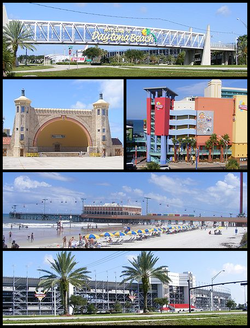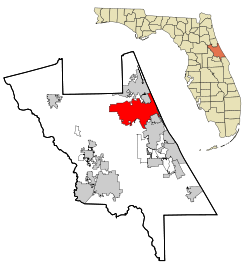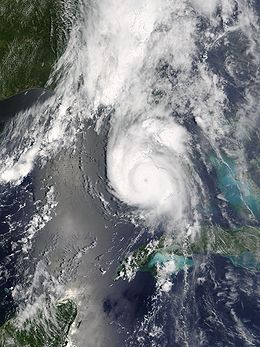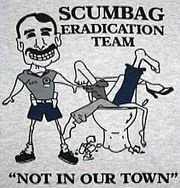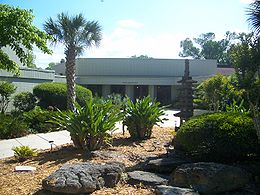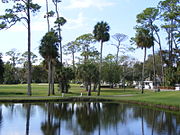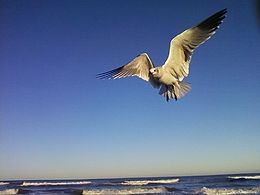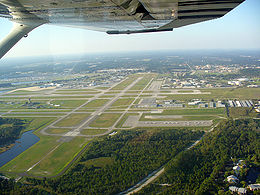- Daytona Beach, Florida
-
Daytona Beach — City — From top, left to right: Welcome sign when entering Daytona Beach; Daytona Beach Bandshell; Ocean Walk Shoppes; Daytona Beach Pier; Daytona International Speedway 
SealNickname(s): The World's Most Famous Beach Location in Volusia County and the State of Florida Coordinates: 29°12′26″N 81°02′16″W / 29.20722°N 81.03778°WCoordinates: 29°12′26″N 81°02′16″W / 29.20722°N 81.03778°W Country  United States
United StatesState  Florida
FloridaCounty Volusia Incorporated July 1876 Government - Type Commission-Manager - Mayor Glenn Ritchey - City Manager James Chisholm Area[1] 1 - City 64.93 sq mi (168.2 km2) - Land 58.68p sq mi (152.0 km2) - Water 6.25 sq mi (16.2 km2) 9.6% Elevation 9 ft (3 m) Population (1 July 2008)[2] 2 - City 64,211 - Density 1,092.6/sq mi (421.9/km2) - Metro 496,575 Time zone Eastern (EST) (UTC-5) - Summer (DST) EDT (UTC-4) ZIP code 32114-32126, 32198 Area code(s) 386 FIPS code 12-16525[3] GNIS feature ID 0281353[4] Website http://www.ci.daytona-beach.fl.us/ Daytona Beach is a city in Volusia County, Florida, USA. According to 2008 U.S. Census Bureau estimates, the city has a population of 64,211.[2] Daytona Beach is a principal city of the Deltona – Daytona Beach – Ormond Beach, Florida Metropolitan Statistical Area, which the census bureau estimated had a 2006 population of 496,575. Daytona Beach is a principal city in the Fun Coast region of the state of Florida.[5]
The city is historically known as having a beach where the hard packed sand allows motorized vehicles to drive on the beach in restricted areas.[6] This hard packed sand made Daytona Beach a mecca for motorsports, with the old Daytona Beach Road Course having hosted races for over 50 years. This course was replaced in 1959 by the Daytona International Speedway. The city is also the headquarters for NASCAR and the Grand American Road Racing Association.
Daytona Beach is a year-round family-friendly resort area, but could also accurately be called a seasonal town, with large groups of out-of-towners descending upon the city for various events, most notably Speedweeks in early February when over 200,000 NASCAR fans come to attend the season-opening Daytona 500. Other events include the NASCAR Coke Zero 400 race in July, Bike Week in early March, Biketoberfest in late October, and the Rolex 24 Hours of Daytona endurance race in January.
History
The area where Daytona Beach is today was once inhabited by the indigenous, Timucuan Indians, who lived in fortified villages. The Timucuas were nearly exterminated by contact with Europeans through war, enslavement and disease and became extinct as a racial entity through assimilation and attrition during the 18th century. The Seminole Indians, descendants of Creek Indians from Georgia and Alabama frequented the area prior to the Second Seminole War.
During the era of British rule of Florida between 1763–1783, the King's Road passed through present day Daytona Beach. The road extended from St. Augustine, the capital of East Florida, to Andrew Turnbull's experimental colony in New Smyrna. In 1804 Samuel Williams received a land grant of 3,000 acres (12 km2) from the Spanish Crown which had regained Florida from the British after the American Revolution. This land grant encompassed the area that would become Daytona Beach. Williams built a slave labor based plantation to grow cotton, rice and sugar cane. His son Samuel Hill Williams would abandon the planatation during the Second Seminole War when the Seminoles burned it to the ground.
In 1871, Mathias Day, Jr., from Mansfield, Ohio, purchased a 2.144.5 acre tract of the former William's Plantation, on the west bank of the tidal channel known as the Halifax River. He built a hotel around which the town arose, which is today the Daytona Beach Historic District. In 1872 due to financial troubles he lost title to his land, residents decide to name the city Daytona in honor of Day as its founder, and incorporated the town in 1876.[7]
In 1886, the St. Johns & Halifax River Railway arrived in Daytona. The line would be purchased in 1889 by Henry M. Flagler, who made it part of his Florida East Coast Railway. The separate towns of Daytona, Daytona Beach and Seabreeze merged as "Daytona Beach" in 1926, at the urging of civic leader J.B. Kahn and others. By the 1920s, it was dubbed "The World's Most Famous Beach".
Daytona's wide beach of smooth, compacted sand attracted automobile and motorcycle races beginning in 1902, as pioneers in the industry tested their inventions. On March 8, 1936, the first stock car race was held on the Daytona Beach Road Course. In 1959, William France created NASCAR and the Daytona International Speedway to replace the beach course. Automobiles are still permitted on certain areas of the beach, at a maximum speed of 10 mph (16 km/h).
 Daytona Beach at dawn looking south.
Daytona Beach at dawn looking south.
Special Events
The city attracts over 8,000,000 tourists each year. It is one of the few places in the world where it is permitted for one to drive a car on the ocean beach.
During motorcycle events (Bike Week and Biketoberfest), several hundred thousand bikers from all over the world visit the greater Daytona Beach area. While the city is often associated with spring break, the efforts of the local government to discourage rowdiness, combined with the rise of other spring break destinations, have nearly ended Daytona's former preeminence as a spring break destination.
Special events that draw visitors to Daytona Beach include:
- Speedweeks (Daytona 500 NASCAR race, Rolex 24 sports car race, and others)
- Coke Zero 400, NASCAR race on or around July 4 (Traditionally called the Pepsi 400 or Firecracker 400)
- Daytona Beach Bike Week Daytona 200 motorcycle races, bike shows and biker reunion in March
- Biketoberfest in October
- Turkey Run car show and events during Thanksgiving weekend (Traditionally called the Turkey Rod Run)
- Spring break (date varies, usually the first and second week of March)
Daytona Beach is also home to the headquarters of NASCAR, Grand-Am, International Speedway Corporation, United States Tennis Association in Florida, and the LPGA.
Geography and climate
Daytona Beach, Florida Climate chart (explanation) J F M A M J J A S O N D 3.147702.749713.854762.558803.365855.771895.272916.173906.672884.56583357772.75071Average max. and min. temperatures in °F Precipitation totals in inches Metric conversion J F M A M J J A S O N D 808217092298122465142783182914521321312233155233216822311141928771425691022Average max. and min. temperatures in °C Precipitation totals in mm Daytona Beach is located at 29°12′26″N 81°02′16″W / 29.207309°N 81.037900°W.[8] According to the United States Census Bureau, the city has a total area of 64.93 sq mi (168 km2). of which 58.68 sq mi (152 km2) is land and 6.25 sq mi (16 km2) is water. Water is 9.6% of the total area.
The city of Daytona Beach is split in two by the Halifax River lagoon, part of the Intracoastal Waterway, and sits on the Atlantic Ocean. It is bordered on the north by Holly Hill and Ormond Beach and on the south by Daytona Beach Shores, South Daytona and Port Orange.
Daytona Beach has a humid subtropical climate, typical of the southeastern United States. Summers are hot and humid with highs usually in the 90s and a heat index often exceeding 100 degrees Fahrenheit. Thunderstorms are frequent in summer afternoons and the hot, humid weather can last right through the fall months. Winters are dry and mild, marked by a constant series of cold fronts and warm-ups. Temperatures dip into the low 30s and upper 20s Fahrenheit on rare occasion, and freezes are not common. Frost occurs a few times a year mainly in the inland areas, but is rare along the beaches; snowfall is extremely rare. Temperatures in spring are famously pleasant with warm afternoons, cool evenings, and far less humidity. This beach-going weather attracts tourists back to the beaches usually by early March.
Despite its warm location, there were a few catastrophic freezes in the area's history. Early settlers only left vague records, but severe freezes were indicated on: January 2–3, 1766; February 7–8, 1835; and January 16, 1857. The cold weather was so severe that crops such as orange trees were killed and several plantation owners abandoned the area as a result.[9][10]
Climate data for Daytona Beach, Florida Month Jan Feb Mar Apr May Jun Jul Aug Sep Oct Nov Dec Year Average high °F (°C) 69.7
(20.9)71.1
(21.7)75.6
(24.2)79.8
(26.6)85
(29)88.8
(31.6)91
(33)90.1
(32.3)87.9
(31.1)82.6
(28.1)76.9
(24.9)71.4
(21.9)80.83
(27.13)Average low °F (°C) 47.1
(8.4)48.8
(9.3)53.7
(12.1)58
(14)64.5
(18.1)70.6
(21.4)72.4
(22.4)72.8
(22.7)71.9
(22.2)65.3
(18.5)57
(14)50.1
(10.1)61.02
(16.12)Precipitation inches (mm) 3.13
(79.5)2.74
(69.6)3.84
(97.5)2.54
(64.5)3.26
(82.8)5.69
(144.5)5.17
(131.3)6.09
(154.7)6.61
(167.9)4.48
(113.8)3.03
(77)2.71
(68.8)49.29
(1,252)Source: USTravelWeather.com[11] Hurricanes and tropical storms
Because of Daytona Beach's proximity to the Atlantic Ocean, the city has a significant chance of receiving hurricanes and tropical storms every hurricane season. However, prior to 2004, major hurricanes are only recorded as skirting by the coast of Daytona Beach without any direct hits.
Hurricane Floyd passed along the Florida coast in September 1999, which caused significant beach erosion and collapsed about 200 ft (61 m). section of the Daytona Beach Pier.
The 2004 Hurricane season was particularly tumultuous in the Daytona Beach area. Hurricane Charley was a very fast-moving, compact storm, which made landfall near Port Charlotte, Florida on the Gulf Coast of Florida, on August 13, swept northeast across the state, and hit Daytona Beach from the inland side before reentering the Atlantic Ocean. Hurricane Frances was a very large storm in size, which moved made landfall at Hutchinson Island South, Florida (near Port St. Lucie, Florida) in the early hours of September 5, and caused a significant amount of collateral damage. Portions of Daytona Beach were without electricity or phone service for ten days following Frances due to downed lines or shorted transformers. Just three weeks later, Hurricane Jeanne formed in the Atlantic Ocean and made landfall only six miles from the same spot Frances hit, at Hutchinson Island South, Florida, on September 26. Following the 2004 Atlantic hurricane season, the names Charley, Frances, and Jeanne were all retired from use.
Tornadoes
Daytona Beach is not immune to the threat of tornadoes. Historical tornado activity is about 33% above the national average. On February 22, 1998 a tornado killed 13 people, injured 36 people, and caused $31 million in damages. Tornadoes also hit the city on Christmas Day, 2006. Some people were injured, but no fatalities were reported. Very significant damage was done to Embry–Riddle Aeronautical University's campus as the F2 tornado that touched down in Daytona Beach cut through the heart of the campus. It destroyed 50 of the school's 75 aircraft, mostly Cessnas. More info can be found: tornadoes of 2006, and at.[13]
Rogue wave
On July 3, 1992, a 27-mile (43 km) long rogue wave hit the Volusia County beaches. The wave's range was from Ormond Beach in the north, to New Smyrna Beach on the south. The crest was 9 feet (2.7 m) high and centered at Daytona Beach. Sailboats crashed ashore onto cars and many people suffered cuts and bruises from glass and debris. Two people required hospitalization and 200 vehicles were damaged. 75 injuries were reported. The prevailing theory is that an underwater landslide caused the rogue wave, although others have theorized that it was the result of a squall line.[14][15]
Law and government
Local Government
Under Daytona Beach's commission-manager form of government, voters elect a City commission which consists of seven members who serve four-year, staggered terms. Six are elected by district, the Mayor is elected city-wide.
The City Commission establishes ordinances and policies for the city. It also reviews and approves the city budget annually. The Commission appoints a City Manager, who carries out the will of the Commission and handles day-to-day business.
Law Enforcement
Law enforcement in Daytona Beach is provided by the 241 member, Daytona Beach Police Department (DBPD) headed by police chief Mike Chitwood. In a unique and controversial program to help fund the Police Explorer program, run by a subsidiary of the Boy Scouts of America, T-shirts with the words Scumbag Eradication Team: Not In Our Town are sold at the police headquarters.[16]
The T-shirts contain a caricature of Chief Chitwood standing next to a toilet bowl with the legs of multiple individuals sticking out. The T-shirt has been cited in at least one lawsuit against the DBPD alleging police brutality, the lawyer in the case in which the client sustained broken ribs and a fractured eye socket during an arrest for an open container of beer, claims the T-shirt shows the DBPD condones violence.[17]
The Volusia County Sheriff's department, headed by Ben E. Johnson is a countywide law enforcement agency with 446 sworn positions, 438 civilian employees, 300 volunteers and an annual operating budget of $73 million that has jurisdiction in unincorporated areas of Volusia County and provides additional law enforcement support to Daytona Beach during such events as the Daytona 500 and aids in joint investigations of certain crimes.[18]
The Volusia County Beach Patrol provides law enforcement as well as EMT services along Volusia County beaches including the beaches in the city of Daytona Beach.[19]
Eminent domain case
The city of Daytona Beach made national headlines when it designated the several mile radius around Main Street on the barrier island portion of the city as a blighted area and has targeted it for redevelopment by private developers. This follows the Supreme Court decision of the eminent domain case in Kelo v. City of New London, which upheld the right of municipalities the right to use eminent domain to take private property for redevelopment by private entities.[20][21][22]
Local elected officials
- Mayor - Glenn Ritchey
- Zone 1 Commissioner - Rick Shiver
- Zone 2 Commissioner - Pamela Woods
- Zone 3 Commissioner - Kelly White
- Zone 4 Commissioner - Robert A. Gilliland
- Zone 5 Commissioner - Derrick L. Henry
- Zone 6 Commissioner - Cassandra G. Reynolds
- City Manager (appointed) - James Chisholm
- Zone Commissioner - Cescely Swindle
Federal, state and county representation
Daytona Beach is part of Florida's 7th congressional district and is part of Florida's 27th Legislative District.
Florida's 7th congressional district, covering portions of Flagler County, Putnam County, St. Johns County, Seminole County and Volusia County, is represented by John Mica (R). Florida is represented in the Senate by George LeMieux (R, Fort Lauderdale) and Bill Nelson (D, Orlando).
The 27th legislative district of the Florida Legislature is represented in the State Senate by Evelyn J. Lynn (R, Ormond Beach) and in the State House of Representatives by Dwayne L. Taylor (D, Daytona Beach). The Governor of Florida is Rick Scott (R). The Lieutenant Governor of Florida is Jennifer Carroll (R).
Demographics
Historical populations Census Pop. %± 1890 771 — 1900 1,690 119.2% 1910 3,721 120.2% 1920 6,841 83.8% 1930 16,598 142.6% 1940 22,584 36.1% 1950 30,187 33.7% 1960 37,395 23.9% 1970 45,327 21.2% 1980 54,176 19.5% 1990 61,921 14.3% 2000 64,112 3.5% Est. 2008 64,211 0.2% Population 1910-2000.[23] As of the census[3] of 2000, there were 64,112 people, 28,605 households, and 13,844 families residing in the city. The population density was 1,092.6 per square mile (421.8/km2). There were 33,345 housing units at an average density of 568.3 per square mile (219.4/km2). The racial makeup of the city was 62.33% White, 32.75% African American, 1.73% Asian, 0.32% Native American, 0.06% Pacific Islander, 1.05% from other races, and 1.76% from two or more races. 3.48% of the population were Hispanic or Latino of any race.
There were 28,605 households out of which 18.0% had children under the age of 18 living with them, 30.1% were married couples living together, 14.5% had a female householder with no husband present, and 51.6% were non-families. 39.4% of all households were made up of individuals and 14.4% had someone living alone who was 65 years of age or older. The average household size was 2.06 and the average family size was 2.77.
In the city the population was spread out with 17.6% under the age of 18, 16.6% from 18 to 24, 25.6% from 25 to 44, 20.5% from 45 to 64, and 19.7% who were 65 years of age or older. The median age was 37 years. For every 100 females there were 99.7 males. For every 100 females age 18 and over, there were 98.5 males.
The median income for a household in the city was $25,439, and the median income for a family was $33,514. Males had a median income of $25,705 versus $20,261 for females. The per capita income for the city was $17,530. 23.6% of the population and 16.9% of families were below the poverty line. Out of the total population, 34.9% of those under the age of 18 and 12.1% of those 65 and older were living below the poverty line.
Culture
The Museum of Arts and Sciences is the primary cultural facility for Daytona Beach and Volusia County. Other museums located in the city include the Southeast Museum of Photography and the Halifax Historical Museum. The Museum of Arts and Sciences is actually a collection of museums and galleries and includes the Klancke Environmental Complex, the Cuban Museum, Root Family Museum featuring one of the largest Coca-Cola(R) collections in the world, the Dow American Gallery and the Bouchelle Center for Decorative Arts which together form what is probably one of the finest collections of furniture and decorative arts in the Southeast. There are also changing exhibitions and a new children's science center opened in 2008.
Daytona Beach in popular culture
Novels set in Daytona Beach include:
- Day Number 142 (1974) by Edgar A. Anderson
- Last Cruise of the Nightwatch (1956) by Howard Broomfield
- Kick of the Wheel (1957) by Stewart Sterling
There have been a number of movies based on Daytona Beach, usually with a racing theme. The most recent example was the 1990 hit Days of Thunder, parts of which were filmed in Daytona Beach and nearby DeLand. Chris Rea wrote the song Daytona which was in his 1989 album The Road to Hell
Daytona Beach was also the destination of a group of plagued teenagers in the movie Final Destination 2.
Sports
Club League Venue Established Championships Daytona Cubs FSL, Baseball Jackie Robinson Ballpark 1993 4 Daytona Beach ThunderBirds AF2, Arena football Ocean Center 2006 0 In addition to motorsports, Daytona is also the home of the Daytona Cubs, a minor league baseball team of the Florida State League and the Daytona Beach ThunderBirds, an arena football team of the AF2.
Golf
There are a number of golf courses in Daytona Beach.
- Club at Pelican Bay:Two courses, North and South Courses
- Daytona Beach Golf Course:Two courses, North and South Courses designed in 1922.
- Indigo Lakes Golf Club
- LPGA International: The headquarters of the LPGA are located in Daytona Beach. The golf club offers two 18-hole courses, Champions and Legends. The golf facilities are owned by the City of Daytona Beach and operated under agreement with the LPGA.
Media
Newspapers
- The Daytona Beach News-Journal - Daily newspaper covering the Greater Daytona Beach Area.
- Hometown News - Weekly newspaper covering Daytona Beach, Holly Hill and Ormond Beach.
- Orlando Sentinel - Newspaper and news site based in Orlando with a bureau covering Daytona Beach and Volusia County.
- The Avion Newspaper - Student college publication of Embry–Riddle Aeronautical University in Daytona Beach.
- The Daytona Times - Black Newspaper covering Daytona Beach
Radio
AM
- WNDB, 1150 AM, Daytona Beach, News/Talk/Sports
- WROD, 1340 AM, Daytona Beach, OLDIES
- WMFJ, 1450 AM, Daytona Beach, Religious
- WPUL, AM 1590 [AM broadcastinglAM, Daytona Beach, Adult Contemporary/Newstalk
FM
- WHOG, 95.7 FM, Daytona Beach, Classic Rock, "The HOG".
- WJLU, 89.7 FM, Daytona Beach, Religious
- WCFB, 94.5 FM, Daytona Beach, Urban Adult Contemporary
- WIKD-LP, 99.1 FM, Daytona Beach, Campus Radio of Embry–Riddle Aeronautical University
- WJHM, 101.9 FM, Daytona Beach, Mainstream Urban "102 JAMZ"
- WVYB, 103.3 FM, Daytona Beach & Holly Hill, Top 40 "1033 The Vyb"
Radio stations in the Daytona Beach, Florida market By AM frequency By FM frequency By callsign Florida Radio Markets: Daytona Beach • Fort Myers-Naples-Marco Island • Ft. Pierce-Stuart-Vero Beach • Ft. Walton Beach • Gainesville-Ocala • Jacksonville • Lakeland-Winter Haven • Melbourne-Titusville-Cocoa • Miami-Ft. Lauderdale • Orlando • Panama City • Pensacola • Sarasota-Bradenton • Sebring • Tallahassee • Tampa-St.Petersburg-Clearwater • West Palm Beach-Boca Raton
Other Florida Radio Regions: The Florida Keys • Lake City
Television
- WESH, Channel 2, digital channel 11, NBC
- WDSC-TV, analog channel 15, digital channel 33, PBS
- Central Florida News 13, Bright House Networks cable channel 13
Economy
A major part of the Daytona Beach area economy is involved in the tourist industry. Over 8 million visitors came to the Daytona Beach area in 2004.
The area's economy includes other industries besides tourism, such as manufacturing. Daytona Beach has industrial sites within an enterprise zone and sites within a foreign trade zone adjacent to Daytona Beach International Airport. Prime Interstate 4 and Interstate 95 sites are available with access to road, air, rail and water transportation.
Companies and organizations that have their corporate headquarters or a major presence in the area:
- Halifax Health
- International Speedway Corporation
- Gambro-Renal Products
- Ladies Professional Golf Association
- NASCAR
- SunTrust Bank
Shopping
- Volusia Mall, 1700 West International Speedway Blvd. The largest shopping mall in Daytona Beach. Anchored by Sears, J. C. Penney, Macy's, and Dillard's.
- Ocean Walk Shoppes, 250 North Atlantic Ave. Open-air shopping center, located in the heart of the beach area.
- Promenade Shopping Center
Education
Public primary and secondary education is handled by Volusia County Schools. Daytona Beach has two public traditional high schools, two middle schools and six elementary schools. Some of the larger private schools include Father Lopez Catholic High School.
Elementary Schools
- Ortona Elementary
- Champion Elementary
- Palm Terrace Elementary
- R.J. Longstreet Elementary
- Turie T. Small Elementary
- Westside Elementary
Middle Schools
- David C. Hinson Middle
- Campbell Middle
High Schools
Colleges and universities
- Bethune–Cookman University
- Daytona State College
- Embry–Riddle Aeronautical University
- University of Central Florida, Daytona Beach Campus
Vocational schools
- The Airline Academy - Offers flight training for pilots and other airline professionals.
- Keiser College
- WyoTech (formerly AMI) Offers automotive repair, motorcycle repair, and marine repair training.
- Phoenix East Aviation - Offers flight training for pilots.
Infrastructure
Health systems
Healthcare in Daytona Beach is dominated by Halifax Health (formerly known as Halifax Hospital). The Halifax Hospital Taxing District was established in 1927 by an Act of the Florida Legislature as a public hospital district.[24] There are dozens of individual practitioners and Professional Associations (PA) in the Daytona Beach area.
Bridges
There are four bridges over the Halifax River (and Intracoastal Waterway) at Daytona Beach. They include (starting from furthest downstream) the Veterans Memorial Bridge (which carries CR 4050 traffic), the Broadway Bridge (which carries US-92 traffic), the Main Street Bridge (which carries CR 4040 traffic), and the Seabreeze Bridge (which carries SR-430 traffic). All four bridges are free to traffic. [25]
Utilities
Basic utilities in Daytona Beach (water and sewer) are provided by the City Government.
- Florida Power & Light is Daytona Beach's local electric power provider.
- TECO/People's Gas is Daytona Beach's natural gas provider. [1]
- Bright House Networks is Daytona Beach's local cable provider.
- AT&T (formerly BellSouth) is Daytona Beach's local phone provider.
The city has a successful recycling program with separate pickups for garbage, yard waste and recycling. Collection is provided by several private companies under contract to Volusia County, Florida.
Transportation
Airports
Passenger airline services are located at Daytona Beach International Airport (DAB), which is centrally located within the city adjacent to Daytona International Speedway. The site was first used as an airport with terminals being constructed in 1952 and 1958. The present facility was constructed in 1992 at the cost of $46 million, and includes both a domestic terminal and an International terminal. Despite the new facilities, DAB has found difficulty in attracting and retaining carriers; Continental Airlines, AirTran Airways, and United Airlines discontinued flights to Daytona in 2007 and 2008.[26] LTU & American Airlines also serviced Daytona Beach during the 1980s and 1990s, both of which ended all flights in 1994 & 1997.
Current passenger airlines serving DAB include Delta Air Lines (with nonstop service to Atlanta) and US Airways (with non-stop service to Charlotte). Both carriers offer connecting service from those cities to destinations worldwide. International flights from DAB fly to destinations in the Bahamas through air taxi and charter services Airgate Aviation and IslandPass; non-stop flights are available from DAB to Marsh Harbour, Treasure Cay, and North Eleuthera.[27] DAB is also heavily used for general aviation, largely due to Embry–Riddle Aeronautical University, whose campus is located at the airport.
Larger airports nearby are Orlando International Airport and Jacksonville International Airport, both of which are approximately one and one half hours away.
Buses
- Daytona Beach is served by Greyhound Bus Lines, which has a terminal located at 138 South Ridgewood Avenue (US-1). The Greyhound routes from Daytona Beach connect with hubs in Jacksonville and Orlando.
- VoTran is the local bus service provided by Volusia County. It is a cheap way to get around and is handicap accessible. Buses travel to most sites and places of interest. A one-day VoTran bus pass costs $3.
- A1A Beachside Trolley operates from January to Labor Day (September) along Atlantic Avenue on the beachside. They are air-conditioned and handicapped accessible.
Auto
Daytona Beach is easily accessible by I-95 that runs North and South and I-4 connecting Daytona Beach with Orlando and Tampa. U.S. 1 (Ridgewood Avenue) also passes through Daytona Beach. A1A is a scenic North/South route along the beach.
The Volusia County Parking Garage is located at 701 Earl Street at North Atlantic Avenue (A1A). The garage is strategically located, next to the Ocean Center, Daytona Lagoon, and across the street from the Hilton Hotel and Ocean Walk Shoppes. Over one thousand parking spaces are available inside the garage, which also houses an intermodal transfer station for VoTran.
Rail
Passenger railroad service to Daytona Beach was established no later than 1889 by the Jacksonville, St. Augustine and Halifax River Railway, predecessor of the Florida East Coast Railroad (FEC). Passenger trains continued calling at Daytona Beach till 1968, when the FEC terminated passenger operations system-wide.
Daytona Beach is served by Amtrak by way of a Thruway Motorcoach connection between the beachside and Amtrak's DeLand Station, 28 miles (45 km) to the west. There, the service connects northbound with train 92, the Silver Star, and train 98, the Silver Meteor. Southbound connections from Daytona Beach are limited to the Silver Meteor's southbound train 97. The DeLand - Daytona Beach service is Amtrak's only Florida Thruway Motorcoach route provided by a taxi-cab, rather than a bus.
Notable residents
- Dan Allen, comedian
- Duane Allman and Gregg Allman, musicians
- Fulgencio Batista, 19th Cuban President
- Vince Carter, basketball player
- Ed Charles, former Major League Baseball player
- Bill France, Sr., founder of NASCAR
- Danielle Harris, actress
- Zora Neale Hurston, writer, anthropologist
- E. J. Kuale, gridiron football defensive end
- Ryan Lochte, 2004 Olympic medalist in swimming
- Mark Martin, NASCAR driver
- Mary McLeod Bethune, educator and civil rights activist
- Walter M. Miller, Jr. - Author of A Canticle for Leibowitz
- Ransom Eli Olds, automobile pioneer
- Josef Papp, engineer
- Glen "Fireball" Roberts, NASCAR driver
- Bob Ross, artist and television host
- David Sholtz, 26th governor of Florida
- Mike Skinner, NASCAR driver
- Howard Thurman, author and theologian
- Rickie Weeks, MLB player for the Milwaukee Brewers
- T. K. Wetherell, president of Florida State University
- Robert Wright, musical theater writer
- Aileen Wuornos, serial killer executed in 2002.
- Smokey Yunick, mechanic and motor racing innovator
Points of interest
- Daytona 500 Experience
- Daytona Beach Bandshell and Oceanfront Park Complex
- Daytona International Speedway
- Daytona Lagoon Water Park
- Halifax Historical Museum
- Jackie Robinson Ballpark
- Main Street Pier
- Mary McLeod Bethune Performing Arts Center and Visual Arts Gallery
- Museum of Arts and Sciences
- News Journal Center
- Southeast Museum of Photography
- The Ocean Center
- List of Registered Historic Buildings in Daytona Beach, Florida
Sister cities
Images
References
- ^ "Florida by place Population, Housing Units, Area and Density:2000". US Census Bureau. http://factfinder.census.gov/servlet/GCTTable?_bm=y&-geo_id=04000US12&-_box_head_nbr=GCT-PH1&-ds_name=DEC_2000_SF1_U&-format=ST-7. Retrieved 2007-07-24.
- ^ a b "Annual Estimates of the population for the Incorporated Places of Florida" (XLS). US Census Bureau. http://www.census.gov/popest/cities/tables/SUB-EST2005-04-12.xls. Retrieved 2007-07-23.
- ^ a b "American FactFinder". United States Census Bureau. http://factfinder.census.gov. Retrieved 2008-01-31.
- ^ "US Board on Geographic Names". United States Geological Survey. 2007-10-25. http://geonames.usgs.gov. Retrieved 2008-01-31.
- ^ "Annual Estimates of the Population of Metropolitan and Micropolitan Statistical Areas: April 1, 2000 to July 1, 2006" (XLS). U.S. Census Bureau. http://www.census.gov/population/www/estimates/metro_general/2006/CBSA-EST2006-01.xls. Retrieved 2007-07-24.[dead link]
- ^ Daytona Beach Guide Overview
- ^ Historic Daytona Beach By Harold D. Cardwell, Priscilla D. Cardwell. p. 7 Publisher: Arcadia Publishing (August 25, 2004) Language: English ISBN 0738516759
- ^ "US Gazetteer files: 2010, 2000, and 1990". United States Census Bureau. 2011-02-12. http://www.census.gov/geo/www/gazetteer/gazette.html. Retrieved 2011-04-23.
- ^ Florida Citrus Mutual: Timeline of Florida Freezes
- ^ Monthly Weather Review, September 1895: Florida Freezes for a Century and a Half
- ^ "Daytona Beach weather". USTravelWeather.com. http://www.ustravelweather.com/weather-florida/daytona-beach-weather.asp.
- ^ Summary report on building performance: 2004 hurricane season By United States. Federal Emergency Management Agency p.6
- ^ http://www.srh.noaa.gov/mlb/surveys/122506/index.html
- ^ NOAA, Florida Weather History: Volusia County
- ^ The Daytona Beach Wave of July 3–4, 1992: A Shallow Water Gravity Wave Forced by a Propagating Squall Line, January 1995
- ^ Scumbag T-Shirt Raises Money For Police Youth Program
- ^ Suit against top cop cites “Scumbag” T-shirt
- ^ Volusia County Sheriff's Office
- ^ Volusia County Beach Patrol
- ^ National Public Radio
- ^ Entrepreneur Magazine
- ^ Daytona Beach Redevelopment Plan
- ^ "Census Of Population And Housing". U.S. Census Bureau. http://www.census.gov/prod/www/abs/decennial/index.htm. Retrieved 2008-10-28.
- ^ Taxing Districts
- ^ Bridge Information 1st Qtr 2011.pdf "FDOT Florida Bridge Information". Florida Dept. of Transportation. http://www.dot.state.fl.us/statemaintenanceoffice/CBR/Florida Bridge Information 1st Qtr 2011.pdf. Retrieved 2011-01-16.
- ^ "DBIA History". Volusia County, Florida. http://flydaytonafirst.com/history.htm. Retrieved 2009-06-16.
- ^ "IslandPass". IslandPass, LLC. http://www.flyislandpass.com/. Retrieved 2009-06-16.
External links
- Daytona Beach travel guide from Wikitravel
- City of Daytona Beach
- Daytona Beach Chamber of Commerce
- Daytona Beach Convention & Visitors Bureau
Municipalities and communities of Volusia County, Florida County seat: DeLand Cities Daytona Beach | Daytona Beach Shores | DeBary | DeLand | Deltona | Edgewater | Flagler Beach‡ | Holly Hill | Lake Helen | New Smyrna Beach | Oak Hill | Orange City | Ormond Beach | Port Orange | South Daytona
Towns CDPs Unincorporated
communitiesAlamana | Allandale | Barberville | Bethune Beach | Boden | Cassadaga | Cow Creek | Creighton | Eldora | Emporia | Enterprise | Farmton | Fort Florida | Lemon Bluff | Maytown | Osteen | Pennichaw | Senyah | Seville | Volusia | Wilbur-By-The-Sea
Footnotes ‡This populated place also has portions in an adjacent county or counties
Categories:- Populated coastal places in Florida
- Cities in Volusia County, Florida
- Beaches of Florida
- Daytona Beach, Florida
- Seaside resorts in Florida
Wikimedia Foundation. 2010.

